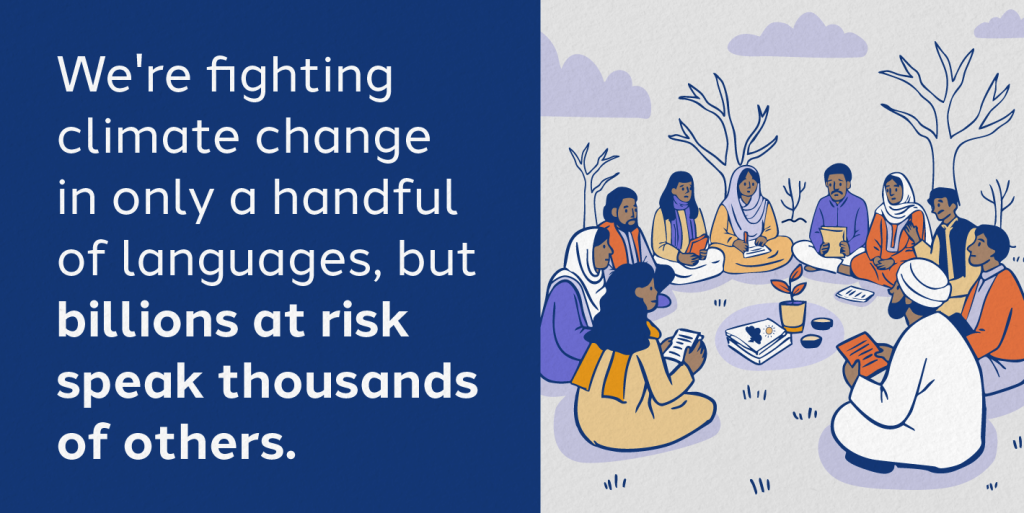The monsoon rains came early to Pakistan in 2022, transforming rivers into roaring torrents that swallowed entire villages. In Nowshera district, as floodwaters receded and displaced families sought help, language became an invisible barrier as devastating as the floods themselves. Pashto-speaking families who had lost everything found themselves unable to navigate the very systems meant to help them. “We went to the government office to register for aid, but we couldn’t explain ourselves properly. The staff didn’t speak our language, and they didn’t seem interested in helping us,” said a displaced person to researchers who studied the vulnerabilities of flood-affected communities. The forms, the health advisories, and the bureaucratic processes often exist in languages that create walls between desperate people and the assistance they urgently need.
This isn’t an isolated failure, but a symptom of a much larger problem. As climate disasters multiply worldwide, language barriers are turning humanitarian crises into communication catastrophes.
A common problem for thousands of languages
Across the world, approximately 3.3 to 3.6 billion people live in regions of high climate vulnerability sprawling across Africa, South Asia, South and Central America, and small island states scattered across rising seas. Aside from climate hotspots, these areas are where humanity’s estimated 7,000 languages flourish in their greatest diversity. In these very regions where the climate emergency hits hardest, the tapestry of human speech is most complex.
Consider the mathematics of vulnerability: the three countries facing the highest risk from natural disasters are linguistic powerhouses. The Philippines, facing recurring typhoons that grow stronger with warming oceans, is home to over 120 languages. Indonesia, an archipelago slowly being submerged, shelters approximately 800 languages among its islands. India, facing catastrophic heat waves, droughts, and floods, speaks 123 major languages – and that’s before counting hundreds of smaller languages that don’t make official statistics.
In order to face up to the climate crisis, populations are in need of plenty of information that is often not delivered in their language. This includes climate resilience programs, training on drought-resistant farming techniques, and early warning systems for extreme weather. But the language gap becomes even more acute during emergencies, when people desperately need evacuation instructions, locations of emergency shelters, trauma counseling services, information about their displacement rights, access to health services, legal assistance navigating compensation programs… Each of these represents not just an information gap, but a justice gap, where those who need help most are systematically excluded from receiving it simply because the help arrives in the wrong language.


A barrier to participation in solution design
In West Papua, Indonesia, local communities speak languages like Dani, Yali, and Asmat – languages that evolved alongside the forests and coastlines they’ve managed for millennia. When these communities try to participate in regional climate planning meetings, they find themselves unable to do so, their profound ecological knowledge locked away behind linguistic barriers they didn’t create.
This knowledge is irreplaceable. In the Amazon, where indigenous communities speak hundreds of languages, each tongue carries detailed information about plant species, water cycles, soil conditions, and animal behavior. Yet these communities are systematically excluded from climate conferences and policy-making processes, not because they lack expertise, but because they lack the “right” languages.
The exclusion happens at every level. Local climate communicators want to help their communities understand what’s happening to their world. But translating complex climate science accurately requires resources and training. This year CLEAR Global had the opportunity to work with Aymara and Tacana Indigenous communities in Bolivia, where we developed glossaries to find precise terminology that will help in upcoming climate emergencies.
Including language in our response to the climate emergency
These problems are replicated billions of times over across climate-vulnerable regions. Each time, the failure goes beyond the logistical issue; it’s a question of fundamental justice. If we cannot speak to people in languages they understand, we cannot help them. If we cannot hear what they’re trying to tell us in their own words, we miss the usefulness of humanity’s wisdom. And if we continue to build our global response to climate change in just a handful of dominant languages, we guarantee that the billions who live in vulnerability’s path will face the crisis alone, excluded from the very conversations that will determine their survival.
The earth is speaking through fires, floods, and storms. But humanity’s response remains trapped in just a few dominant languages, leaving billions in silence.
If this means something to you, please consider donating to CLEAR Global. We work to ensure everyone suffering the consequences of climate change can find information and be heard, no matter what language they speak.